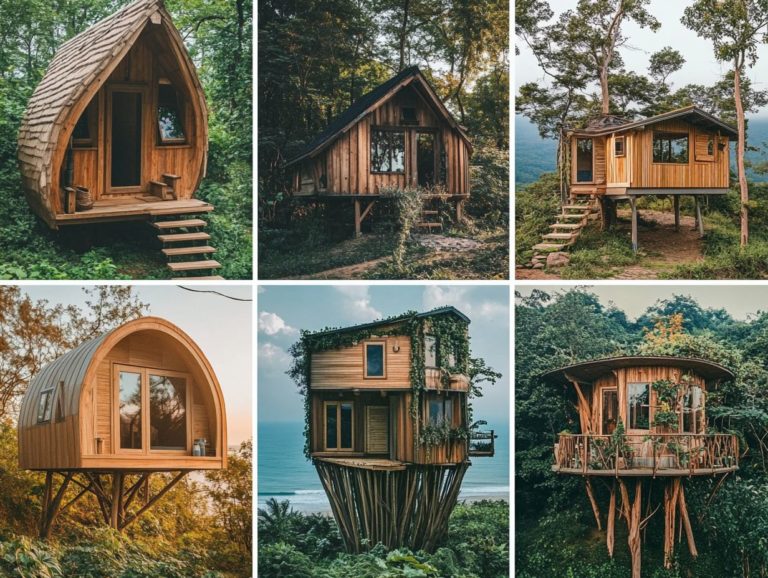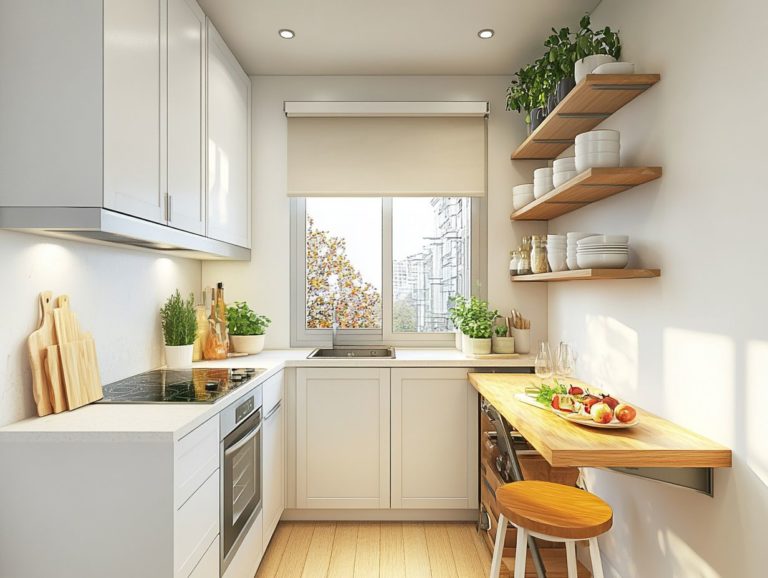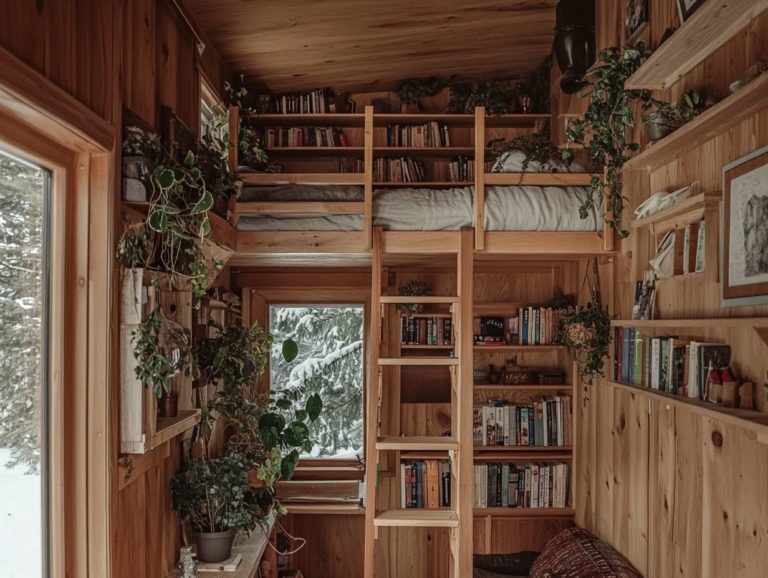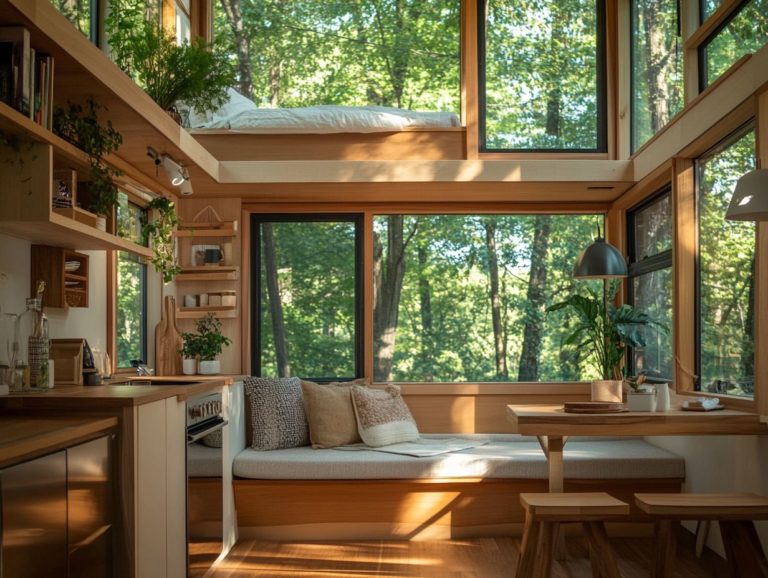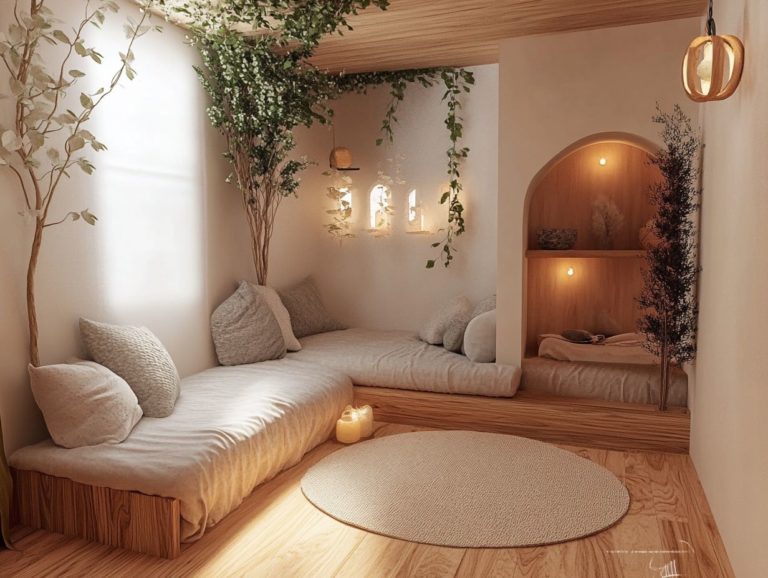Color Schemes That Work in Tiny House Interiors
Choosing the right color scheme for your tiny house can significantly enhance both its charm and functionality.
With limited space, every hue matters. Whether you opt for serene neutrals that create an airy feel or bold colors that make a striking statement, the right palette can transform your home into a cozy sanctuary.
Let’s explore the exciting factors that will help you choose the perfect colors! This article delves into how to create a sense of visual space in small areas, the advantages of incorporating accent colors, and the role of natural elements.
Discover how vibrant or peaceful your tiny home can truly be!
Contents [hide]
- Key Takeaways:
- Choosing the Right Color Scheme for Tiny House Interiors
- Neutral Color Schemes for Tiny House Interiors
- Bold and Bright Color Schemes for Tiny House Interiors
- Creating a Cohesive Color Scheme
- Using Accent Colors in Tiny House Interiors
- Incorporating Natural Elements in Color Schemes
- Frequently Asked Questions
- What are some popular color schemes that work well in tiny house interiors?
- How can I use neutral tones in a tiny house interior color scheme?
- Are there any colors I should avoid using in a tiny house interior?
- Can I use different color schemes in different areas of my tiny house?
- How can I create a cohesive color scheme in my tiny house interior?
- What are some ways to add color to a neutral color scheme in a tiny house interior?
Key Takeaways:
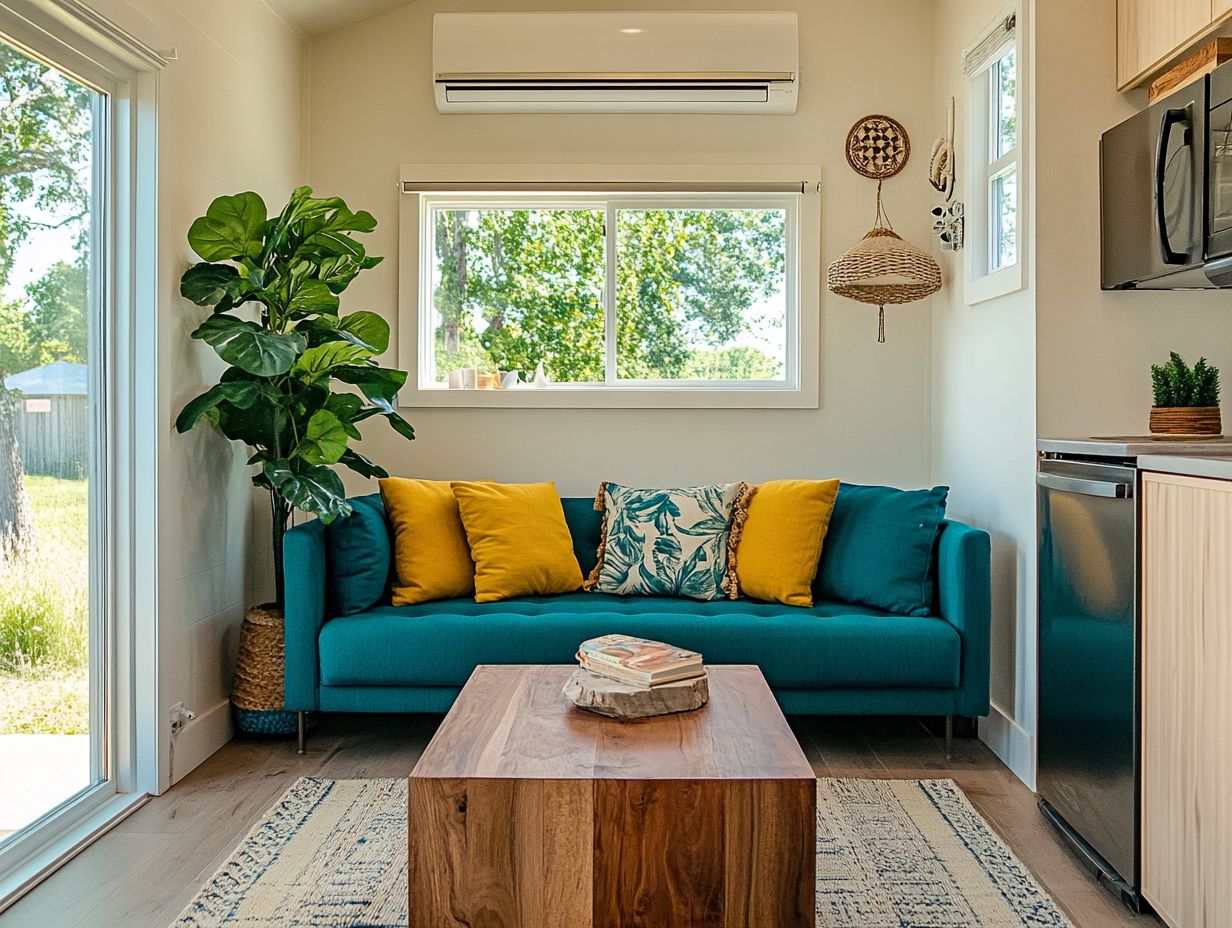
- Choose a color scheme that reflects your personal taste while considering the size and layout of your tiny house.
- Neutral color schemes make tiny house interiors feel bigger and more open, allowing for personalization through accent pieces and textures.
- Bold and bright colors can add personality and make a statement in a small space. Balance them with neutral elements to avoid overwhelming the area.
Choosing the Right Color Scheme for Tiny House Interiors
Selecting the perfect color scheme for your tiny house interiors is essential, as it profoundly impacts both aesthetic allure and the perception of space within your home. With the limited square footage typical of tiny living, choosing the right palette can turn a cozy nook into a spacious retreat, elevating both functionality and comfort.
Colors can evoke a range of emotions and shape how you experience a space. Interior designers consistently highlight the significance of this decision to craft harmonious, inviting environments that make the most of every square inch in your tiny abode.
Factors to Consider
Consider several key factors when choosing your tiny house color scheme, grounded in how colors affect feelings and design elements that shape space perception.
The availability of light significantly affects how colors appear throughout the day, impacting not just aesthetics but also the overall mood of your space. It s essential that existing design elements like cabinetry or flooring harmonize with your chosen hues to achieve a cohesive look.
Your desired atmosphere will guide your choices. Do you prefer a calm, serene environment or a vibrant, energizing feel? Personal preferences are key here, whether you re drawn to earthy tones or bold accents, especially in a compact setting.
Utilizing lighter colors can create an illusion of expanded space. At the same time, strategic pops of color can serve as focal points, enhancing comfort and warmth in your cozy abode.
Neutral Color Schemes for Tiny House Interiors
Neutral color schemes present a sophisticated option for tiny house interiors, crafting a calming atmosphere that transforms small spaces into open and inviting havens, ideal for a monochromatic scheme.
By embracing a neutral palette of light hues and earthy tones, you can establish a serene backdrop that offers both design flexibility and visual intrigue. Interior designers often advocate for these palettes, as they enhance natural light and seamlessly pair with accent colors, adding character without overwhelming the space.
Benefits and Examples
Embracing a neutral palette in tiny home interiors offers countless benefits. It effortlessly crafts a calming atmosphere while also providing abundant opportunities for visual intrigue through texture and design.
Selecting shades like soft beige or light taupe significantly enhances the natural light flowing through your space, making each room feel brighter and more inviting. For instance, a pastel blue accent wall adds a delicate splash of color without overwhelming the senses.
Earthy tones such as sage green or warm terracotta introduce a grounding essence, reminiscent of the tranquility found in nature. When these variations harmonize, they create depth and dimension, transforming small areas into cozy retreats that exude a sense of expansiveness.
Choosing the right neutral shades elevates the aesthetic and fosters a serene living environment, perfect for unwinding after a long day.
Bold and Bright Color Schemes for Tiny House Interiors

Bold and bright color schemes can transform tiny house interiors into colorful spaces full of character, reflecting your unique style in a captivating way. Incorporating lively pops of color like ruby red or sapphire blue creates focal points that draw the eye and enhance visual interest in confined areas.
Some might hesitate to use bold colors in smaller spaces. However, when applied thoughtfully, these hues invigorate and energize your tiny home, providing a striking contrast to neutral backgrounds that enhances the overall appeal. For more tips, check out this guide on how to use color to create space in tiny homes.
Making a Statement with Color
Making a statement with color in your tiny home requires a strategic approach. Bold colors enhance design elements and introduce visual interest without overwhelming the limited space.
Master the art of color application by creating an accent wall that draws the eye without dominating the room. Pair it with thoughtfully chosen furniture pieces in complementary shades to maintain a harmonious balance.
Renowned interior designers suggest a unifying palette. For example, pairing a vibrant emerald green accent wall with muted, neutral tones in your furnishings creates a stunning focal point. Remember, moderation is key; incorporating texture further enhances the overall effect without cluttering your visual space.
Creating a Cohesive Color Scheme
A cohesive color scheme makes your tiny home shine! It’s vital for maximizing visual space and fostering a harmonious living environment, especially when every detail matters in limited square footage.
The artful blending of colors boosts aesthetic appeal and cultivates a seamless flow throughout your interiors, enhancing unity and tranquility. Interior designers often recommend developing a palette featuring shades and tones from the same color family. This method creates subtle variations that enrich the overall design, making your space feel both sophisticated and inviting.
Tips and Tricks for Mixing Colors in a Small Space
Mixing colors in a small space, like a tiny home, requires thoughtful consideration and a few strategic tips for a visually appealing and harmonious result.
One effective approach is using a simple tool that helps you find colors that go well together. Incorporating a variety of textures, such as woven fabrics or metallic accents, adds visual depth to your space, making it feel larger and more inviting.
Interior designers stress the importance of balance. Avoid overly bright shades in confined areas to maintain tranquility, while using pops of color as accents adds intrigue without overwhelming your senses.
Keep your palette uncluttered to prevent chaos, creating a serene and cohesive environment. Try these tips today to bring your tiny home to life!
Using Accent Colors in Tiny House Interiors
Incorporating accent colors into your tiny house interiors is an exquisite way to infuse personality and vibrancy into your space. This approach allows you to introduce delightful pops of color that invigorate the environment while maintaining a harmonious design.
Addition of a Pop of Color to Brighten a Space

Adding a pop of color to brighten a tiny house space isn t just about design; it creates visual interest that can significantly enhance the overall ambiance.
Imagine introducing vibrant textiles throw pillows or blankets in bold hues that instantly uplift the room’s spirit. A simple chair in a striking shade can completely transform minimalist furniture, adding both functionality and flair.
The psychological effects of color are truly fascinating. For example, a soft blue can evoke a sense of tranquility, while a bright yellow can spark creativity and joy.
By thoughtfully selecting accessories, such as a colorful area rug or artwork that resonates with your personal style, you can craft a harmonious yet dynamic atmosphere. This approach allows you to maintain a cozy, inviting feel without overwhelming the space.
Incorporating Natural Elements in Color Schemes
Incorporating natural elements into your color schemes for tiny homes elevates the aesthetic appeal while fostering a deep connection with the outdoors. You ll often find that using earthy tones and organic materials creates a harmonious atmosphere that resonates with the beauty of nature.
Bringing the Outdoors In
Bringing the outdoors in is a cornerstone of tiny house design, enabling you to craft serene spaces that resonate with nature through deliberate choices in color and natural elements.
This concept elevates the visual appeal of your home and fosters a profound sense of well-being. To effectively achieve that seamless indoor-outdoor flow, consider incorporating large windows that frame breathtaking views and welcome an abundance of natural light, brightening your spaces while minimizing reliance on artificial lighting.
Using natural materials like wood and stone further strengthens your connection to the outdoors. Delving into color psychology can greatly enhance the ambiance; soft greens and earthy browns can evoke feelings of tranquility and warmth.
For instance, pair a sage green wall with a warm, sandy beige accent. This combination transforms your space into a cozy retreat that reflects the charm of a sunlit forest.
Frequently Asked Questions
What are some popular color schemes that work well in tiny house interiors?
Some popular color schemes for tiny house interiors include neutral tones, bright and bold colors, and monochromatic color palettes.
How can I use neutral tones in a tiny house interior color scheme?
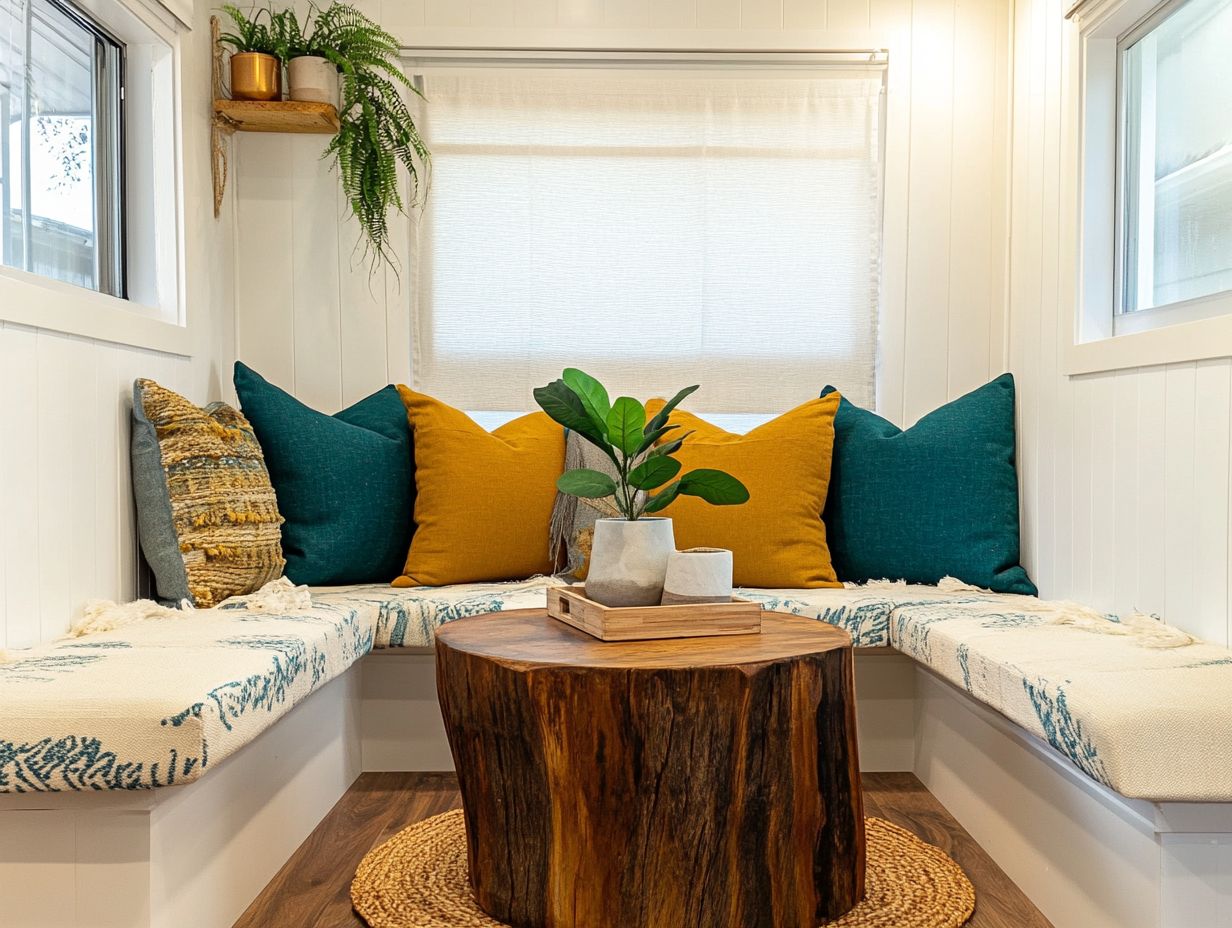
Neutral tones such as white, beige, and gray create a sense of spaciousness and calm in a tiny house. They can also serve as a backdrop for pops of color in furniture or decor.
Are there any colors I should avoid using in a tiny house interior?
It’s best to avoid dark and heavy colors in a tiny house interior, as they can make the space feel even smaller. Stick to lighter, brighter colors to create an open and airy feel.
Can I use different color schemes in different areas of my tiny house?
Absolutely! Using different color schemes in different areas can help define the various spaces and add visual interest to your tiny house interior. Don’t hesitate to experiment! Different color schemes can truly define your spaces!
How can I create a cohesive color scheme in my tiny house interior?
One way to create a cohesive color scheme in a tiny house interior is to use a monochromatic color palette. This means using different shades and tones of the same color throughout the space.
What are some ways to add color to a neutral color scheme in a tiny house interior?
You can add pops of color through accent walls, throw pillows, rugs, and artwork. Incorporating plants or flowers can also add both color and life to a neutral color scheme.
Have more questions? Feel free to ask!
Start decorating your tiny home with color today!

